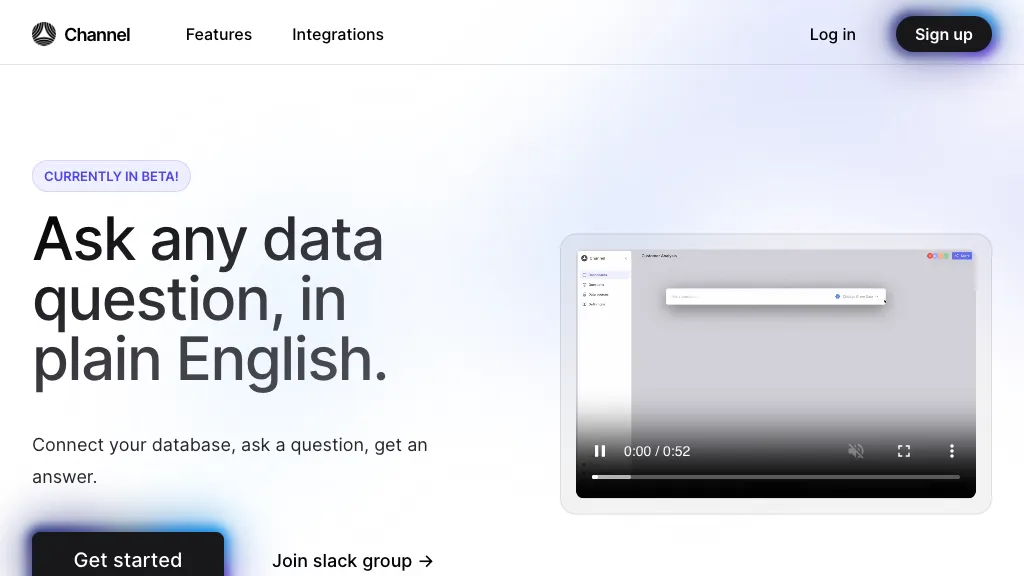What is Channel?
Channel is AI-driven. Users can thus ask questions in pure English to have integrated database responses in return. The tool hence does not require any SQL knowledge, hence opening up data insights to an expanded market. Channel also provides automated visualizations in consideration with data preferences and team collaboration to improve the usage of the data. It integrates with popular data warehouses like Snowflake, BigQuery, and Redshift. Thus, it secures data storage and its encryption practices.
Key Features & Benefits of Channel
Channel is a singular tool known for its strong feature base and variety associated with benefits that come with its use, including:
- It allows the user to formulate data questions in simple English.
- Generates an answer automatically from the connected databases.
- Self-service data insights, not requiring vast SQL knowledge from users.
- Automatic visualizations by user data preferences.
- Enabling teams to be better informed and harness data collaboratively.
Such features make this tool very vital to data analysis, improving efficiency, usability, and improving collaboration among team members.
Use Cases and Applications of Channel
Channel AI can be applied in several scenarios across different industries as follows:
- Analyze sales data fast enough to identify trends and opportunities.
- Collaborate with team members to understand customer behavior better.
- Comprehensive reporting on marketing campaigns.
This flexibility is most useful to data analysts, business intelligence professionals, decision-makers, and citizen data scientists.
How to Use Channel
Getting started with Channel is quite simple:
- Integrate Channel with your favourite data warehouse: for instance, Snowflake, BigQuery, Redshift.
- Ask questions related to the data in plain English.
- Get auto-answers and visualizations for your questions.
- Interpret and use the data insights collaboratively with the team.
For unlocking all of the power in Channel, the lines of communication need to be very clear between each member of your team, and there needs to be constant iteration toward refinement on data questions to align with business objectives.
How Channel Works
These advanced AI algorithms interpret plain English questions and fetch relevant data from connected databases. The NLP technology at work here helps in understanding the user query, while the machine learning models are used for generating accurate responses. Thus, the whole workflow—querying the databases for data and processing it to present in an easily digestible visual format—makes the data analysis and decision-making process easy.
Pros and Cons of Channel
However, as with any tool, the Channel has its pros and cons:
Pros:
- No SQL knowledge is required, and insights get democratized across non-technical users in the organization.
- Collaboration across teams would be much easier due to shared visualizations and insights.
- Easy integration with quite popular data warehouses for an easy pull of information.
- Protection of sensitive information through enterprise-grade secure data storage and encryption.
Cons:
- An initial set-up and integration time is needed with the data warehouses.
- There could be some case for training users how to formulate good data questions.
- Quite a few of the users appreciate that this is easy to use and that it will also be fairly intuitive to many users without a deep understanding of the underlying technology, plus collaboration is an option.
- Others said it would be good to have some more advanced options on data manipulation.
Conclusion about Channel
Channel AI has to be the game-changer for organizations democratizing data insights. The ease of use of this AI-powered tool, therefore, definitely makes it one of the instruments of choice for technical and non-technical users. Turning out to be very useful, Channel has enabled team collaboration and security in the handling of data for any data-driven organization. The potential is only going to increase with future updates and new developments, hence making it a really indispensable tool in this domain of data analysis.
Channel FAQs
Which databases does Channel integrate with?
Channel supports popular data warehouses such as Snowflake, BigQuery, and Redshift.
Do I need to know SQL to use Channel?
Absolutely not. Channel is designed for self-service data insights. No SQL necessary.
How secure is Channel?
We implement secure design in data storage and encryption, so your data’s safe.
Can I use Channel in my team?
Yes, Channel provides features for team collaboration to gain better insights and leverage the data.
What kinds of visualizations does Channel provide?
Channel comes with automated visualizations of preference in data to assist in its better interpretation.










